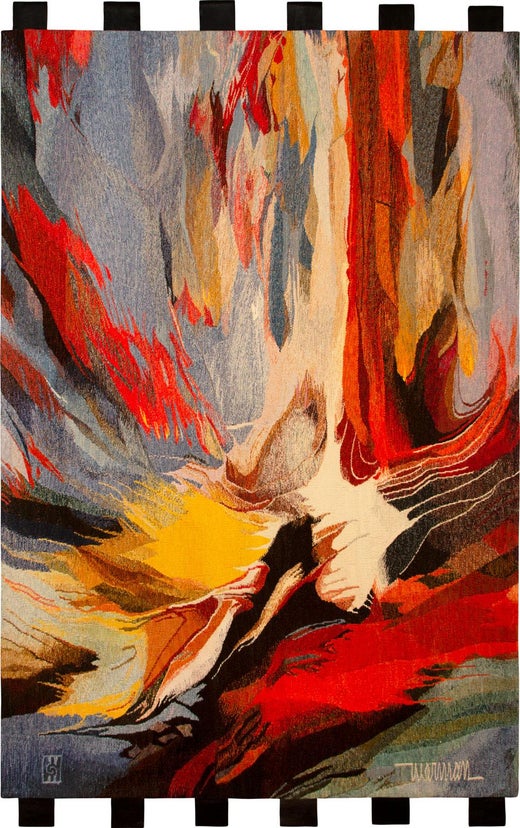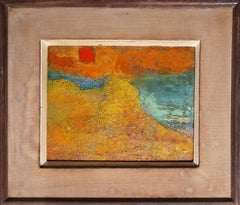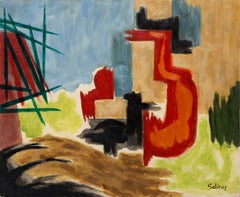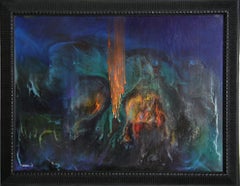Want more images or videos?
Request additional images or videos from the seller
1 of 5
Leonardo NiermanCiudad Prismatica, Abstract Painting by Leonardo Nierman1963
1963
Price:$3,840
About the Item
- Creator:Leonardo Nierman (1932, Mexican)
- Creation Year:1963
- Dimensions:Height: 25 in (63.5 cm)Width: 33 in (83.82 cm)
- Medium:
- Movement & Style:
- Period:
- Condition:In very good condition.
- Gallery Location:Long Island City, NY
- Reference Number:1stDibs: LU4668699892
Leonardo Nierman
Leonardo Nierman is a Mexican abstract artist. His varied paintings and sculptures are inspired by both nature and classical musicians like Johann Sebastian Bach and Claude Debussy, as well as an array of artists that includes David Alfaro Siqueiros, Wassily Kandinsky, and Joan Miró. Nierman’s paintings utilize bright colors and evoke elemental natural events like volcanic eruptions, storms, and waterfalls. In the same vein, his sculptures often depict abstracted sublime representations of angelic figures and flames. Born on November 1, 1932 in Mexico City, Mexico to Lithuanian and Ukrainian parents, Nierman studied the violin from a very young age before receiving a BA in business administration from the Universidad Nacional Autónoma de México. Today, the artist’s works are in the collections of the Museum of Modern Art in Mexico City, the Museum of Fine Arts in Boston, the Detroit Institute of the Arts, and the Indianapolis Museum of Art, among others. Nierman lives and works in Mexico City, Mexico.
About the Seller
4.9
Platinum Seller
Premium sellers with a 4.7+ rating and 24-hour response times
Established in 1979
1stDibs seller since 2014
3,129 sales on 1stDibs
Typical response time: 1 hour
Authenticity Guarantee
In the unlikely event there’s an issue with an item’s authenticity, contact us within 1 year for a full refund. DetailsMoney-Back Guarantee
If your item is not as described, is damaged in transit, or does not arrive, contact us within 7 days for a full refund. Details24-Hour Cancellation
You have a 24-hour grace period in which to reconsider your purchase, with no questions asked.Vetted Professional Sellers
Our world-class sellers must adhere to strict standards for service and quality, maintaining the integrity of our listings.Price-Match Guarantee
If you find that a seller listed the same item for a lower price elsewhere, we’ll match it.Trusted Global Delivery
Our best-in-class carrier network provides specialized shipping options worldwide, including custom delivery.You May Also Like
Series 67 No.4 abstract oil painting by Jack Wolsky
Located in Hudson, NY
Series 67, No. 4 (1955)
Oil on masonite
48" x 24 ½"
49" x 25 ¼" x 1 ¾" framed
About this artist: Jack Wolsky was born in 1930 in Rochester, New York.
He taught in the Department o...
Category
1950s Abstract Abstract Paintings
Materials
Masonite, Oil
industrial landscape
Located in Indianapolis, IN
Signed lower left.
Mary Gehr was born in Chicago around 1910 and toured as an ingénue with the Chicago Opera Ballet for four years, summered with the Schubert Light Opera Company, a...
Category
Mid-20th Century Abstract Expressionist Mixed Media
Materials
Masonite, Oil
Original Leonardo Nierman Abstract Painting Oil on Masonite Framed Purple
By Leonardo Nierman
Located in Buffalo, NY
An original oil on masonite painting by well listed Mexican artist Leonardo Nierman.
This work comes in a unique gold frame presentation which is likely original to the piece.
Si...
Category
1960s Abstract Expressionist Abstract Paintings
Materials
Masonite, Oil
$3,116 Sale Price
20% Off
H 30 in W 24 in
"Caroline #2"
By Gershon Benjamin
Located in Lambertville, NJ
Ashley John is proud to offer this artwork by:
Gershon Benjamin (1899 - 1985)
Gershon Benjamin is a painter of portraits, landscapes, still lives, and the urban scene. He had a pro...
Category
20th Century Abstract Abstract Paintings
Materials
Masonite, Oil
'Masses' by Marc Barker, Oil on Panel Painting
Located in Oklahoma City, OK
This 40" x 40" oil on masonite panel by artist Marc Barker was painted in charcoal and sepia tones, and was created in an 'old world' grisaille style.
"This monochromatic abstract harkens back to my collegiate studies, and as a graduate student teaching zoology with the hours spent staring into a microscope mystified by the primordial world just out of site, a bacterial/protozoan cloud chamber...
Category
Early 2000s Abstract Abstract Paintings
Materials
Oil, Masonite
'Abstract Landscape', by Katherine Westphal, Oil on Board
Located in Oklahoma City, OK
Katherine Westphal's oil on board painting titled 'Abstract Landscape' embodies the stylistic qualities of abstract painting. Using a diverse color palette of orange, red, yellow, bl...
Category
Mid-20th Century Abstract Landscape Paintings
Materials
Masonite, Oil
$1,840 Sale Price
20% Off
H 24.25 in W 30.25 in D 0.875 in
Large Geometric Abstract Oil Painting on Masonite
Located in San Francisco, CA
Large Geometric Abstract Oil Painting on Masonite
No visible signature
36 x 48 unframed, 37.5 x 49.5 framed
Category
Mid-20th Century Abstract Abstract Paintings
Materials
Masonite, Oil
The Investigation of the Investigation, abstract oil, bold colorful dots & grey
By C. Dimitri
Located in Brooklyn, NY
Oil, acrylic, resin on masonite
Category
2010s Abstract Expressionist Abstract Paintings
Materials
Resin, Masonite, Oil, Acrylic
$2,700
H 48 in W 48 in D 2.01 in
"The Cowboy" Mid Century Abstract Expressionist Female Artist
By Sylvia Rutkoff
Located in Arp, TX
Sylvia Rutkoff (1919-2011)
Sr11-1
c.1960s
“The Cowboy”
Oil impasto on Masonite
42x36 period frame
Signed on reverse in pencil
Collection acquired from family estate
Category
Mid-20th Century Abstract Expressionist Landscape Paintings
Materials
Oil, Masonite
$6,000
H 36 in W 42 in D 1 in
"Crossed Arms" Mid Century Abstract Expressionist NYC Female Artist
By Sylvia Rutkoff
Located in Arp, TX
Sylvia Rutkoff (1919-2011)
Sr5-1
c.1960s
“Crossed Arms”
Acrylic on Masonite
36x42 period frame
Unsigned
Collection acquired from family estate
Category
Mid-20th Century Abstract Expressionist Landscape Paintings
Materials
Masonite, Oil
$4,000
H 36 in W 42 in D 2 in
More From This Seller
View AllAbstract Landscape, Oil on Masonite by Female Artist Miriam Bromberg
By Miriam Bromberg
Located in Long Island City, NY
Abstract Landscape
Miriam Bromberg
Date: circa 1960
Oil on Masonite
Size: 7.5 x 9.25 in. (19.05 x 23.5 cm)
Frame Size: 13 x 15 inches
Category
1960s Abstract Abstract Paintings
Materials
Masonite, Oil
Abstract Exterior, Oil Painting by Laurent Marcel Salinas
By Laurent Marcel Salinas
Located in Long Island City, NY
Artist: Laurent Marcel Salinas, French (1913 - 2010)
Title: Untitled, Grass 263
Medium: Oil on Masonite, signed LR
Size: 15 x 18 inches
Category
1950s Abstract Expressionist Abstract Paintings
Materials
Masonite, Oil
Un Fuego Magico, Abstract Expressionist Oil Painting by Leonardo Nierman
By Leonardo Nierman
Located in Long Island City, NY
Artist: Leonardo Nierman
Title: Un Fuego Magico (Variation)
Year: 1965
Medium: Oil on Masonite, signed and dated l.r.
Size: 24 x 31.5 inches
Frame: 28 x 36 inches
Category
1960s Abstract Abstract Paintings
Materials
Oil, Masonite
Judaica Oil Painting By Shmuel Brand
By Shmuel Brand
Located in Long Island City, NY
Artist: Shmuel Brand, German/Israeli (1921 - )
Title: Untitled
Year: 1980
Medium: Oil with Mixed Media on Masonite, signed l.l
Size: 39.5 x 27.5 in. (100.33 x 69.85 cm)
Category
1980s Abstract Abstract Paintings
Materials
Masonite, Oil
Zebuwl 2, Abstract Oil on Masonite by Warren Wolf
By Warren Wolf
Located in Long Island City, NY
Artist: Warren Wolf, American (1924 - 2003)
Title: Zebuwl 2
Year: 1990
Medium: Oil and Marble Dust on Shaped Masonite, signed, titled and dated verso
Size: 34 in. x 31 in. (86.36 cm...
Category
1990s Abstract Geometric Abstract Paintings
Materials
Marble
Yashal & 'Aniyah #2, Abstract Oil on Masonite by Warren Wolf
By Warren Wolf
Located in Long Island City, NY
Artist: Warren Wolf, American (1924 - 2003)
Title: Yashal & 'Aniyah #2
Year: 1996
Medium: Oil and Marble Dust on Shaped Masonite, signed, titled and dated verso
Size: 32 in. x 34 in....
Category
1990s Abstract Geometric Abstract Paintings
Materials
Marble
Recently Viewed
View AllRead More
Romare Bearden’s Humanity Infuses His Bright, Bold Art
Through collage, painting and printmaking, the artist foregrounded Black life in America in revolutionary new ways.
Chryssa’s 1962 Neon Sculpture Was Way ahead of the Art-World Curve
By working with lettering, neon and Pop imagery, Chryssa pioneered several postmodern themes at a time when most male artists detested commercial mediums.



